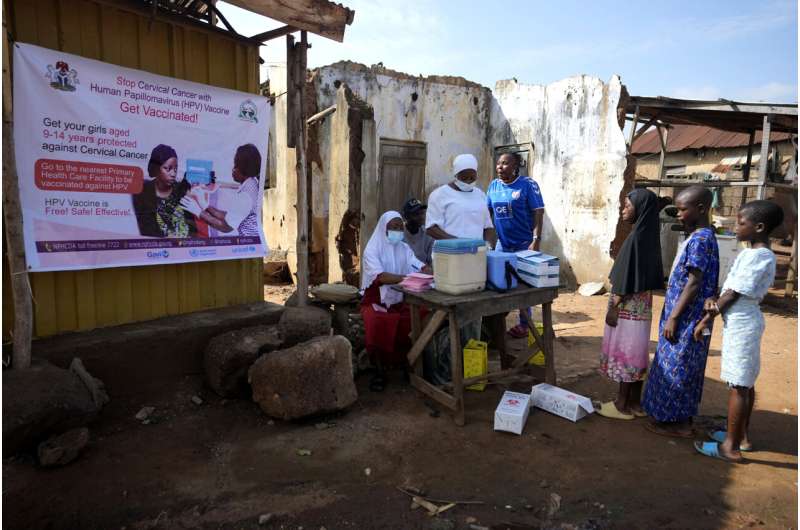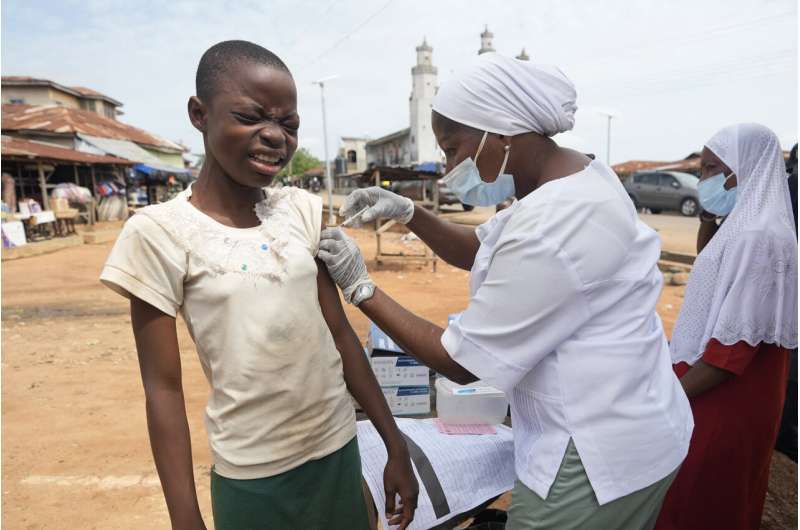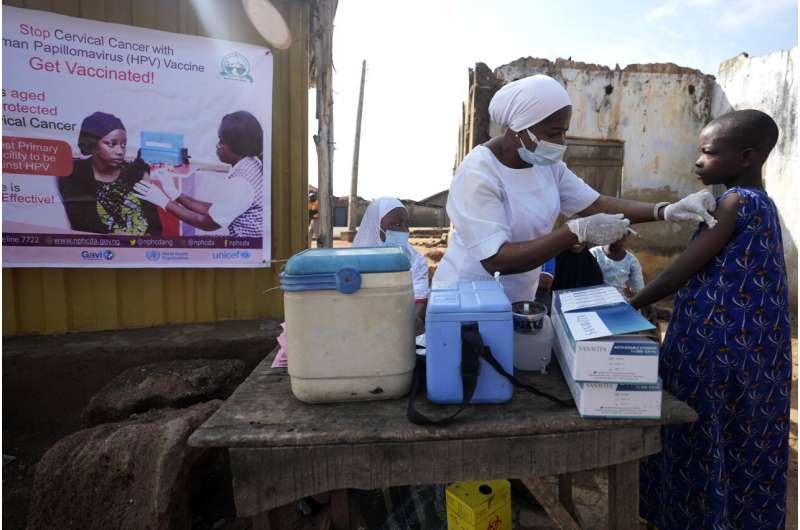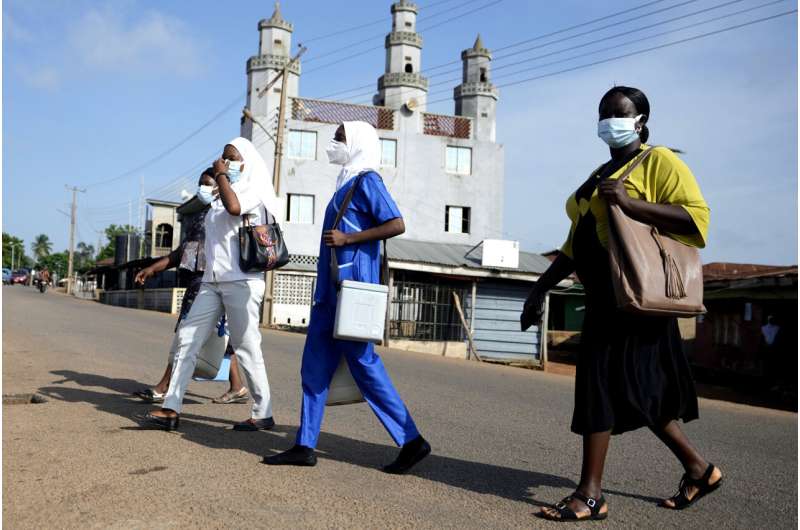Yunusa Bawa spends a lot of time talking about the vaccine for the human papillomavirus that is responsible for nearly all cases of cervical cancer. But on most days, only two or three people allow their daughters to be vaccinated in the rural part of Nigeria where he works.
The challenge in Sabo community, on the outskirts of the capital of Abuja, is the unfounded rumor that the HPV vaccine will later keep young girls from giving birth.
“The rumor is too much,” said Bawa, 42.
As more African countries strive to administer more HPV vaccines, Bawa and other health workers tackle challenges that slow progress, particularly misinformation about the vaccine. The World Health Organization’s Africa office estimates that about 25% of the population still has doubts about it—reflecting concerns seen in some other parts of the world in early campaigns for the vaccine.
A common sexually transmitted virus, HPV can cause cervical cancer, certain other cancers and genital warts. In most cases, the virus doesn’t cause any problems, but some infections persist and eventually lead to cancer.
Across Africa, an average of 190 women died daily from cervical cancer in 2020, accounting for 23% of the deaths globally and making it the leading cancer killer among women in the WHO Africa region of 47 countries. Eighteen of the 20 countries with the highest rate of cervical cancer cases in the world are in Africa. Yet the region’s HPV vaccination rate has been low.

More than half of Africa’s 54 nations—28—have introduced the vaccine in their immunization programs, but only five have reached the 90% coverage that the continent hopes to achieve by 2030. Across the region, 33% of young girls have been vaccinated with HPV.
It’s a stark contrast to most European countries, where both girls and boys have been receiving HPV shots.
Part of why Africa has a high burden of cervical cancer is because of limited access to screening for women, said Emily Kobayashi, head of the HPV Program at the vaccines alliance Gavi.
“The elimination strategy is a long game … but we know that vaccination is the strongest pillar and one of the easiest to implement,” Kobayashi said.
But “it is one thing to introduce the vaccine, but if the vaccine remains in the fridge, it doesn’t prevent cervical cancer,” said Charles Shey Wiysonge, head of the vaccine-preventable diseases program in the WHO’s Africa region. He said information must be provided by people “who are trusted, people who are close to the communities.”

There is a long history of vaccine hesitancy in many African countries that is sometimes linked to a lack of trust in government, as one study published in the Nature science journal in May found, giving room for conspiracy theories and misinformation from social media influencers and religious leaders.
In Zimbabwe, where cervical cancer is the most frequent cancer among women, a group of mostly women known as Village Health Workers have been trained to raise awareness about cervical cancer and the HPV vaccine in rural areas. But they fight a high level of hesitancy among religious sects that discourage followers from modern medicines, asking them to rely instead on prayers and “anointed” water and stones.
The women who eventually agree to be screened for cervical cancer do so in secret, said Zanele Ndlovu, one of the health workers on the outskirts of Bulawayo city.
For a deeply religious country like Zimbabwe, “the spiritual leaders have so much influence that a lot of our time is taken trying to educate people about the safety of vaccines, or that they are not ungodly,” Ndlovu said.
There are also success stories in Africa where authorities have achieved up to a 90% vaccination rate. One example is Ethiopia, which relies heavily on religious leaders, teachers and hotline workers.

In Rwanda, the first African country to implement a national HPV vaccination program in 2011, the coverage rate has reached 90%. Hesitancy is less of an issue due to vigorous awareness work that has relied on school-based campaigns and community outreach programs, said Dr. Theoneste Maniragaba, director of the cancer program at Rwanda Biomedical Center.
Mozambique has deployed school-based programs, a door-to-door approach and mobile outreach for girls in hard-to-reach areas that has helped it reach 80% coverage rate with the first of two doses. In Tanzania, where the HPV vaccine has been in use since at least 2018, authorities in April launched a campaign to target over 5 million girls and further raise coverage, which has reached 79% of girls with the first dose.
One of Africa’s largest HPV vaccination drives targeting girls recently kicked off in Nigeria, which has procured nearly 15 million doses with the help of the U.N. children’s agency. It will target girls aged 9–14 with single doses that the WHO’s African immunization advisory group has said is as effective as the regular two doses.
One challenge is explaining the HPV vaccination to girls ahead of the onset of sexual activity, especially in conservative societies, said Dr. Aisha Mustapha, a gynecologist in northern Kaduna state.
Mustapha has been successfully treated for cervical cancer. She said the experience helps in her meetings with religious leaders and in community outreach programs in Kaduna, where she leads the Medical Women Association of Nigeria.

They try to make the girls feel comfortable and understand why the vaccine is important, she said. That sometimes requires comic books and lots of singing.
“The (cervical) cancer … is no respecter of any identity,” she said. “The vaccine is available, it is free, it is safe and effective.”
© 2024 The Associated Press. All rights reserved. This material may not be published, broadcast, rewritten or redistributed without permission.
Citation:
More African nations focus on HPV vaccination against cervical cancer, but hesitancy remains (2024, June 24)
retrieved 24 June 2024
from https://medicalxpress.com/news/2024-06-african-nations-focus-hpv-vaccination.html
This document is subject to copyright. Apart from any fair dealing for the purpose of private study or research, no
part may be reproduced without the written permission. The content is provided for information purposes only.

